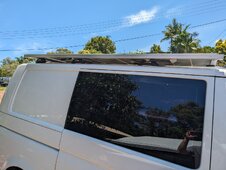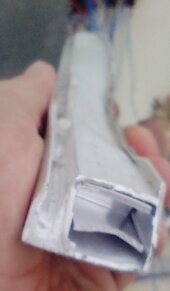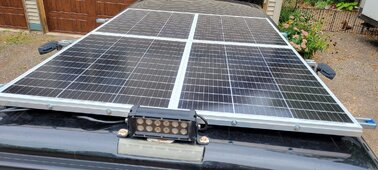Unclebob
New Member
- Joined
- Jul 8, 2022
- Messages
- 8
I've installed 3 X 200w renogy panels on my van (on top of roof racks. They're all bolted together with angle section aluminium so I can lift them off with some pulleys in my garage when I want to use my roof racks for their intended purpose. It works, but it's noisy at highway speeds (the interplay between the aero bars and the frames can atrocious noise at times) and I'm trying to keep height to a minimum so I can still get into local carparks etc.
My probably stupid question: has anybody tried removing the frames and using something like foam core fibreglass ribs to provide stiffness to the panels instead? I imagine it'd be similar weight to aluminium but far stiffer, and could potentially run across all 3 panels, effectively making them one large panel. It could also be far more aerodynamic, as the sides facing the wind could have most of the face removed, leaving a sort of air intake. This would also assist with venting heat when stationary
Possible issues:
- removing the existing frames without damaging the glass/cells
- finding a suitable method to bond the foam/epoxy to the panels
- preventing deterioration/failure due to UV exposure
Any thoughts? Suggestions on how to get the frames off without damaging the glass/cells? Slaps around the head for my stupid ideas?
My probably stupid question: has anybody tried removing the frames and using something like foam core fibreglass ribs to provide stiffness to the panels instead? I imagine it'd be similar weight to aluminium but far stiffer, and could potentially run across all 3 panels, effectively making them one large panel. It could also be far more aerodynamic, as the sides facing the wind could have most of the face removed, leaving a sort of air intake. This would also assist with venting heat when stationary
Possible issues:
- removing the existing frames without damaging the glass/cells
- finding a suitable method to bond the foam/epoxy to the panels
- preventing deterioration/failure due to UV exposure
Any thoughts? Suggestions on how to get the frames off without damaging the glass/cells? Slaps around the head for my stupid ideas?





